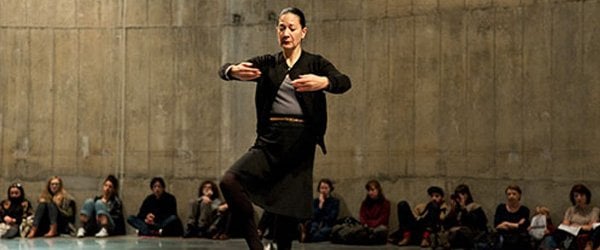
Photographer: Gabrielle Fonseca Johnson
Home | Blog | The Complete Works
The Complete Works
The room was close, commandeered by a swarm of bees shifting almost imperceptibly in the search for their queen. The queen in question was Meryl Tankard. The room, a gallery space within the MCA. The event under scrutiny Nina Beier’s Sydney Biennale curatorial version of her performance series titled The Complete Works. I caught sight of Meryl when heads aligned just so and her face became distinguishable from the crowd. Her task at hand; to dance every work she ever performed. Was it excellence or a morbid fascination which initially compelled my presence here, to see something that I might not ever get a chance to see in my lifetime? I felt guilty, like an ambulance chaser racing to a scene of destruction, or a rubbernecker caught in the throes of somebody else’s downfall. Hopefully this was not going to be that kind of tragedy.
I had only ever gleaned the back catalogue of Pina Bausch via the small viewfinder on YouTube. I had only ever experienced her idiosyncratic theatricality, consisting of a mixture of an unrelenting physicality, punctuated with pedestrian gesture and a wry humour peppered with a poignant fragility, in facsimile. Meryl had performed for Pina for over twenty years, so I, like many, knew Bausch’s works would feature heavily in Meryl’s forthcoming repertoire.
To begin Meryl punctured the impenetrable rabble. With a few deft manoeuvres, we parted like the red sea and I became excited by the fact that I may have discovered an ulterior performative layer, her true purpose interactive, that she might carve the crowd, her body a scythe cutting and shaping an unfolding path. The random close proximity of strangers straining to see, jostling for better vantage points, provided promise. For a short moment I was satisfied with this state, I was prepared to realise my part in this exercise, which was to act as a blade of grass or wheat, tended and cultivated by sources outside my control. It was here I spied willing co-conspirators in academics and journalists.
I shared false commiserations, because in truth this was as close to a rave as I was going to get (since the mid-nineties). I didn’t even care that the lights were on, that there was a notable absence of glow in the dark accoutrements and that I was going to remember every detail afterward.
Then as soon as it began, it was over. We had found our positions as traditional observers and Meryl had asserted her spatial boundaries as performer.
I recognised most of the repertoire before recognising/realising/or rationalising the similarity of this act to those of some of the ceremonies I have seen and performed in when on remote Aboriginal residencies. When in Christmas Creek in the Kimberly region more than 26 years ago, I saw men dance with elaborate woollen woven kites resting on their shoulders. I have seen other men dance with similar painted back boards depicting either a dreaming story or country. Those men were simultaneously here and there. They existed in this chronological time and that fluid dreaming as did Ms Tankard. She was able to mobilise our collective minds. With Meryl as guide I travelled to a virtual realm, for those that knew that era, to that time and for those that experienced her performance first hand, to those places and with those people in attendance.
Not knowing Nina Beier’s work I watched other iterations via YouTube. The difference between this (Meryl’s) performance and others seemed to be the spatial confines. Other performer bodies appeared as solitary figures, able to move about freely, in their own memory bubble.
I was (and am still) interested in the interaction between the titled artist and performer in this instance because there is substantial performative product in this the 2016 Sydney Biennale. I can’t help but feel that the performative body has become currency in a process of artistic corporatisation. The body, and therefore the intellect that is housed in that body, has been appropriated and becomes a mere instrumental element, the (almost) unaccredited component sitting at the bottom of the artistic pyramid, whereby the owner of a singular idea sits atop. If this were a dance production my choreographic collaborators, because this is how I see Meryl in this instance, would demand more credit. This hierarchical structure, which is slowly being dismantled in the contemporary dance community, seems to be enjoying a resurgence within this context.
This leads to other questions of the human dancer and the dance as interdisciplinary component in contemporary artworks. Where does the legacy or lineage of dance history fit into these works? It is a given that as dance practitioners we are beholden to familiarise ourselves with the visual arts movements and tropes of history. If the dancing body were truly to afford its own dedicated museum or gallery it would be fabulous to see that dance could at some point be honoured or acknowledged in its own right, without the need for validity being bestowed upon it by other more prestigious disciplines who may be discovering a concept already well-trodden within the dance.
Despite my superstitious unease I enjoyed seeing Meryl perform. She definitely hasn’t lost it and I left thinking that I would like to see this woman dance for this time. I anticipate the day Meryl Tankard adds to her repertoire of memories choreographer if not performer.
Vicki Van Hout

